Every action is seen to fall into one of three main categories, guarding, hitting, or moving. Here, then, are the elements of combat, whether in war or pugilism.
British military theorist Sir Basil Liddell Hart may have died before video games became popular, but his quote neatly covers the basics of video game combat. Combat is a popular and major component of a video game player's moves and activities. A good combat system requires much thought and work from the development team in order to get it right. But before we dive into combat, we need to open and look into the messy can of violence.
The simple truth is this: many video games are violent.
Let me amend that.
Video games are about action. Some of those actions, like hitting, shooting, stabbing and killing, are violent.
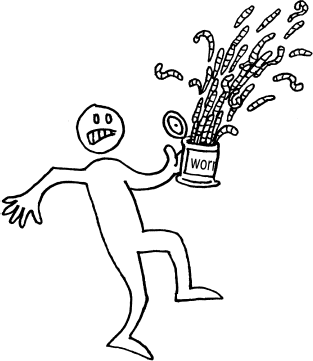
However, anyone who assumes that all video games are violent obviously knows nothing about video games. A large number of video games don't rely on violence, from the first video game, Tennis for Two, all the way to the latest iPhone puzzle game. I could fill this entire book with a catalog of non-violent games. But somehow, it's always the Dooms, Mortal Kombats, and Grand Theft Autos that get all of the attention. Why? Because:
The player does an action (hitting, shooting), sees the immediate result (enemy is killed by attack), which grants a reward (experience, money, power-up). This elegant feedback loop allows for quick and frequent player-to-world interaction. It's Freud's pleasure principle[117] in practice. Ring the bell, a reward is gained. Why stop ringing the bell?
Another reason why violence is common in video games is that other human interactions like conversation, romance, comedy and manipulation are hard to recreate in games! The result is (a) alternate methods of gameplay aren't explored by development teams as often as violent ones. (b) Because game players tend to buy the same types of games over and over, (c) publishers find that newer styles of play are harder to sell.[118] (d) Parents and other social groups who mean well don't always find out all of the facts before leaping to the assumption that all video games are violent.
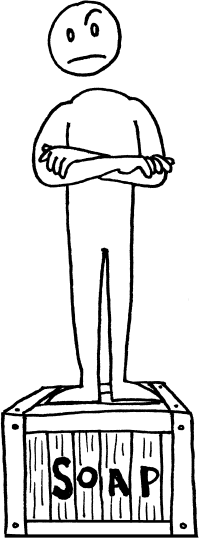
Let's avoid all of this stress by doing our part as responsible members of society and keep mature games out of the hands of younger gamers. There are plenty of alternative games out there. You wouldn't take a little kid to a R-rated movie, so why would you let them play a M-rated video game?
As mentioned back in Level 3, the ESRB reviews and provides ratings for game content. At their website[119] you can find their descriptors of violence found in games:
Comic mischief. Depictions or dialogue involving slapstick or suggestive humor.
Cartoon violence. Violent actions involving cartoon-like situations and characters. May include violence where a character is unharmed after the action has been inflicted.
Fantasy violence. Violent actions of a fantasy nature, involving human or non-human characters in situations easily distinguishable from real life.
Violence. Scenes involving aggressive conflict. May contain bloodless dismemberment.
Intense violence. Graphic and realistic-looking depictions of physical conflict. May involve extreme and/or realistic blood, gore, weapons and depictions of human injury and death.
When designing violence in games you should realize that it's all about context. The more violent activities the player does themselves, the higher the rating. Ask yourself these following questions to help determine the proper rating for your game:
Does the player do the violence themselves? Do they use realistic weapons?
How frequently does the player perform the violent act?
Does the game reward the player for performing violent acts? Does the game show that violence is "not appropriate" in any way?
How graphic is the violence? Is there dismemberment? Do the game visuals linger on the violence?
Is there leftover residue like bloodstains or gibs? Better graphics equal more realistic graphics equals more realistic violence.
Is the violence against "bad guys?" Do the enemies suffer as they are being killed/defeated?
Now that you know how violent your gameplay will be, let's start to design how it is going to happen.
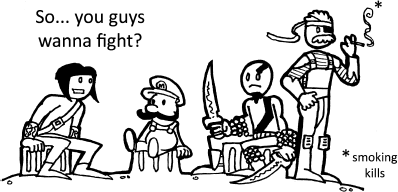
When designing combat moves for your character, first consider your character's personality. Is your character acrobatic like the Prince of Persia? Is your character jumpy like Mario? Stealthy like Solid Snake? Brutal like Kratos? Each of these characters has a uniquely different combat style because they have uniquely different personalities.
What genre is your game? What kind of gameplay experiences do you want the player to have? These questions will help determine your character's weapons. Or maybe you just have your hero carry a laser scimitar and a phase-plasma pistol. Either way is fine.
Study real-world fighting styles to make your character's attacks feel more realistic and distinct. Give your character a signature weapon. It will help quickly define their personality to the player. Can you picture Cloud Strife without his huge sword or Bayonetta without her guns? Your character's weapon is going to dictate how they fight. Rygar's throwable shield creates a different combat experience than a Big Daddy's melee drill. Even if your hero uses an unconventional weapon like a giant spatula or bubble wand, brainstorm all the different uses to which the player could put them. The more original, the better!
Now that you've chosen your weapon, let's fight!
In combat, the attack used totally depends on the player's distance to the target. Check out the four ranges of combat: close range, medium range, long range and area effect.
Knowing what your character's combat range (or ranges) is going to be makes a huge difference in how the player approaches combat during gameplay. A Mario game is almost exclusively close/medium range combat whereas Contra is a long range combat game. As a result, Mario must come into close contact with enemies in order to defeat them, while in Contra, the player's goal is to keep away from enemies and keep them from ever getting close by shooting them at a distance.
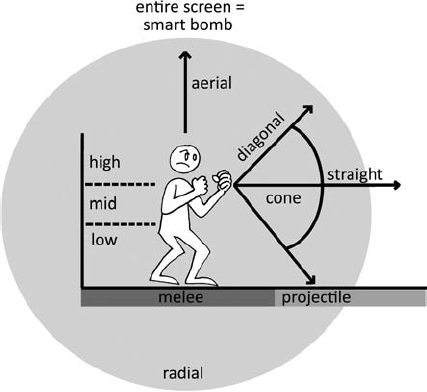
Close range combat consists of grapples, punches, strikes, sweeps, tickle fights, and quick burst moves like head butts and upper cuts.
Medium range combat consists of weapon swings, flying kicks, and dash attacks.
Long range combat consists of shooting or throwing projectiles or spells at enemies.
Area effects, like smart bombs and "super" attacks will affect enemies at long range or on the entire screen.
In addition, attacks can be delivered from four different elevations to give combat variety: standing, low, high, and aerial. While you don't have to use all four of these elevations in your game, you will have to make each of these elevations have their own set of attacks as they make the player deal with combat in very different ways:
Standing position is the basic shoulder height of the player. Man-sized and larger opponents can be struck at this elevation.
Low position strikes are at the waist height (or lower) of the enemy and delivered from a crouched or kneeling position.
High position attacks are delivered over the head of an average height enemy. They can only be done by jumping then attacking. High attacks are used against flying or large enemies like bosses.
Aerial position is when a player has jumped or flown into the air to attack. Aerial attacks can be extended jumps like those found in Devil May Cry and Dante's Inferno or they can be true flying like in Marvel Ultimate Alliance or Dark Void.
Attacks from any elevation and range can be delivered both vertically and horizontally. In Maximo: Ghosts to Glory we designed enemies that could only be defeated by one of the two attacks.
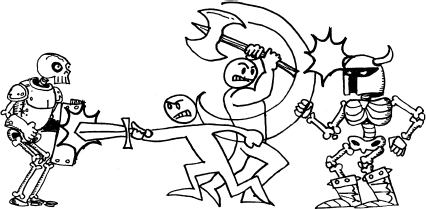
A skeleton guard wore an armored helmet that deflected Maximo's overhead vertical attack. Another skeleton warrior used a shield that blocked Maximo's horizontal attacks. The solution was to use the opposite direction attacks to smash the skeletons.
Attack | Control | Range | Speed | Direction | Damage | Special |
|---|---|---|---|---|---|---|
Slash | Square | Close | Med | Horizontal | Medium (10 hps) | Can be blocked by shield |
Overhead strike | Triangle | Close | Med | Vertical | Medium (10 hps) | Can be thwarted by helmet |
Thrust | Forward on stick, Triangle | Close | Fast | Forward | Strong (25 hps) | Knockback to target |
Jump strike | X, down on stick, Triangle | Close/medium | Slow | Downward | Strong (25 hps) | Stun to any target in two-unit radius |
An attack matrix like the one above is useful to track important information about combat moves. An attack matrix should include the following data:
Attack name
Control scheme
Range of attack
Speed of attack
Direction of attack
Damage—in terms of strength as well numeric damage (usually expressed as a value or percentage)
Special—anything that distinguishes the attack from other attack moves
Feel free to add as many columns as you might need to your attack matrix to accommodate degrees of severity, defensive items/moves, and so on.
You can use an attack matrix to track combat moves and compare and contrast values for maximum variety. Each attack should be distinct and usable in a specific combat situation.
Timing is one of the major keys to great combat. When the player presses a button, the character should quickly perform the attack. If you want your combat animations to feel smooth, then you must strive to have your game run at 60 frames per second. While many games run satisfactorily at 30 fps, lagging and stuttering that can happen at these lower frame rates will really impact your player's combat experience. Don't waste time with long and elaborate wind-up animations. If you do this, it will throw off the player's timing and they may end up missing or striking when they don't want to. Quick moves can be rapidly done in succession, but they tend to lead to button mashing.
Lunges are more fluid thrusts that return the player back to his original standing position. By combining quick strikes and lunges you can create a combat chain that will keep the player's basic attack from feeling boring.
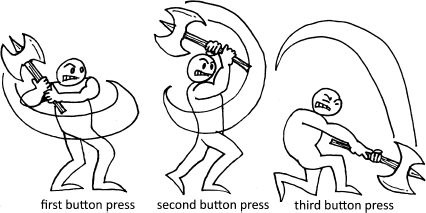
To create a combat chain, create three or more attack moves that will run one after another. If the player presses the attack move once, play the first animation. If the player presses the button again within a short (usually within a second) time period, the player goes into a second attack move. Usually, this second attack move deals more damage, so there is an advantage for the player to "chain" these attacks together. A third attack will do even more damage, and so on.
If the player is allowed to land multiple hits in a row, make sure that your animation (or game code) also moves the player character forward; otherwise, when the enemy is knocked back, the player won't be able to land the next attack in the chain. The hero in the image below misses because he doesn't translate forward. His attack only succeeds when he shifts forward.

OK, remember when I told you back one page ago that you shouldn't do elaborate wind-up animations? I meant it—but only on that page. Elaborate wind-ups are awesome because they lead to powerful attacks that can chop a player in two! These moves work great when the player is wielding an oversized or heavy weapon. Because of the long wind-up, the player is forced to risk the wait for the reward of landing a more powerful attack! Risk vs reward. Remember it. It's gonna be big.
Speaking of rewards, use particle and visual effects to make attacks feel more dynamic and rewarding; from "slice streaks" on sword attacks and speed lines for dash moves like those seen in the Onimusha games, or resort to those old standbys of fire trails and blood splatters like in Madworld (Sega, 2009). Be big, be dynamic, and be dramatic! Give big action moves like ground pounds and smashing uppercuts big screen effects that fill the screen with debris, dust, lightning bolts and other eye-catchers. The more spectacular the better!
So what happens when you actually hit something? A strike without a reaction animation from the enemy doesn't feel like the player has hit anything. It's like the attack is merely skipping off the surface of the enemy. If you can't afford to have the enemy have reaction animations (due to memory limitations, for example) at least have effects and sound effects that indicate that a successful hit has landed. Powerful sound effects make attacks feel more rewarding. Vocal reactions such as a big "Oof!" from enemies are always satisfying!
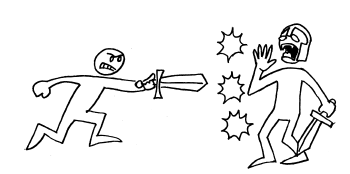
Exaggerate the impact of a powerful hit to heighten the feeling of strength of the attack and increase drama. The enemy should react to wherever they've been hit. Got cracked in the coconut? The enemy's head (and some teeth) should fly. Kick out their leg and a bone should splinter or they should at least topple to the ground. This kind of animation is getting easier to do within the game code using rag doll physics systems like Havok and PhysX, but sometimes nothing beats good old fashion key frame animation.
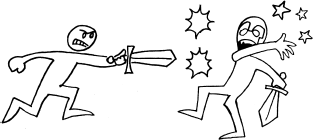
If conflict is drama, then combat should be a freakin' opera complete with flying spear-carrying valkyries and a glass-shattering fat lady! Hype up that drama! A particularly powerful strike should be accompanied with a camera shake, a rumble from the controller's actuator or combat slowing down to show off the power of the hit. Batman: Arkham Asylum uses slow motion to indicate that the player has defeated the last of the enemies in a combat encounter.
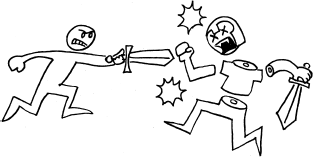
Before I forget, here's a pearl of wisdom: close battles are more exciting. Don't get me wrong, kicking hordes of enemies' asses can be quite satisfying, but just make sure that your player is evenly matched to his skill level for the majority of the game.
You can really pull out all of the stops if you use a cinematic finishing move where the action slows or freezes and the camera pans around the action. These finishes are frequently seen in fighting games like the Soul Calibur and Street Fighter titles, but they've crept into other action games since they just look so darn cool! This is because of this very important thing:
And nothing makes a player look cooler than a QTE. Just look at the Mighty Bedbug in action below. You have to admit that pressing button prompts to create a choreographed combat sequence makes the battle look spectacular.

Case in point: Batman's combat in Batman: Arkham Asylum relies on QTEs to choreograph combat moves rather than leaving the player to flounder around on their own. Why? Because Batman is a badass. He'd never miss a punch. Why should the player? The result? When the player successfully does an attack using a QTE, the player feels like an expert of combat—just like Batman.
While QTEs have been around since Dragon's Lair, they can be found in some of the most recent action games. They are combat-oriented minigames that are activated within combat when an enemy or boss has reached a certain level of health. The player has to press a certain button or complete a certain move (like waggle a motion controller or analog stick) within a very short window of time. If the player is successful, they are rewarded with an animation of the hero performing an elaborate attack on an enemy. Most QTEs require several button presses for the player to reach the end of the sequence, which ends in the death of the enemy or boss.
Here are some tips when designing QTEs:
Reserve QTEs only for the most bombastic and elaborate attacks. Since control during QTEs is limited, ask yourself "is this something the player can do instead?" You can always use single button QTEs like those found in Darksiders or Batman: Arkham Asylum as finishing moves.
Always position the button prompt in the same location on screen. Otherwise the player will get confused about what button they have to press.
Allow the player time to recognize the button prompt and then press the button. This recognition usually takes most players a beat (a "one-one hundred" count).
If the player fails to press the correct button in time, then try to get the player back to that QTE state quickly. For example, if it took three different sets of patterns to reach the QTE, don't repeat those three sets if the player fails. Have the player repeat one set before the QTE is activated.
I'm torn over instant player kills for failing QTEs. On the one hand, it allows for some very bitchin' animations of your hero getting ripped apart by the boss monster. On the other hand, I'm against instant kills in general. I recommend the player taking substantial damage from failing a QTE sequence, that way they can survive to try again. If they are on their last bit of health, you can still have that bitchin' animation play ...
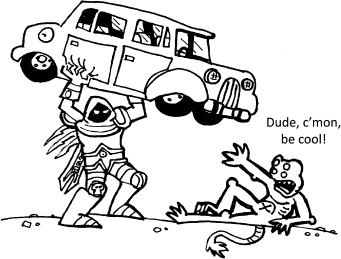
I have played targeting systems that allow the player to choose enemies in front or behind them by selecting a specific button or direction with the analog stick[120]. Other games treat targeting like a QTE, where the window of opportunity to attack lasts as long as the enemy is in view or nearby.
Melee is hand-to-hand combat. Pretty much all the rules of combat apply but remember that those hands can be lethal weapons and hold impromptu weapons found in the world: props or objects such as lead pipes, chairs, or even cars! Make it easy for players to pick up and drop these items—provide on-screen prompts if you have to.
When designing weapons, think about their speed, their range, the damage they do and what other effects they may have, such as fire or poison. If a weapon is upgradable, then make sure the effects are seen on the weapon. Merely adding a +3 to the stats doesn't provide the player with the gameplay information and visual rewards that they deserve.

While swinging a weapon around, be mindful of it sorting through objects. That just looks bad. Instead, have weapons respond to the world, such as rebounding off of stone or metal surfaces or blades sinking into wooden ones. Be aware of the flipside of this, that the player's weapon will rebound off of any non-breakable item in the world. Carefully design your combat environments to use this to the player's advantage and disadvantage. For example, a hero would learn he couldn't swing his giant axe around in an arena filled with unbreakable stone pillars lest he risk rebounding off of them, which would give the skeletons a chance to attack.
Stealth kills are quick attacks used to kill or disable an enemy in one move without alerting other enemies nearby. They are usually performed from a crouch or cover position or by positioning the player behind their target. They often use QTE style prompts to activate and reward players with dramatic enemy kills. Make sure that stealth kills can only be done under certain conditions (in the right position, while under cover, while in shadow), otherwise players will constantly use them over regular attacks as an exploit. Don't let a cool move become stale to the player.
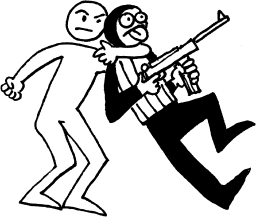
Grapples are similar to stealth kills in that a player can activate them under specific circumstances. Grapples are rare in most games with the exception of the fighting and wrestling genres (for example, WWE Smackdown vs. Raw 2010 (THQ, 2009)). It's difficult to program two-character collision as it requires the main character and the enemy to be animated together so the moves look natural and sorting doesn't occur. However, if you take the time and effort, you can have your hero pull off some pretty devastating attacks and slams. Just like with grabbing items, make it easy for players to grab and release their opponents. Many games make this a context-sensitive move.
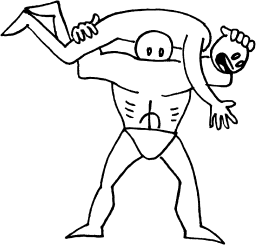
What's another way to make the player look like an expert? Use a lock-on system. The later Legend of Zelda games have a particularly good lock-on system in which the player can lock onto the enemy closest/in front of them with a button press and flick the analog stick to select the next one over to the right or left. As long as the button remains depressed, the player is locked on to an enemy. As each enemy is dispatched, the targeting system latches onto the next available enemy. Lock-on systems require HUD visuals to help the player track their targets. Here are some examples:
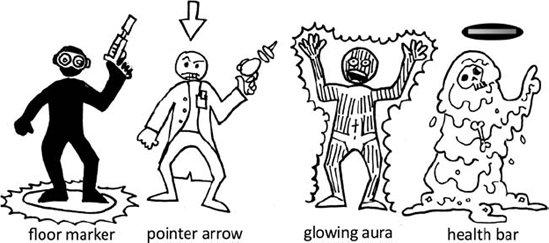
Letting the player miss isn't such a bad thing. The player will be forced to become more skilled with their attacks, which will make them feel like more of a badass as they master combat timing. Or if the player just doesn't get it, you can always increase an enemy's collision dynamically if the player misses or dies too many times in a row. Or you can offer to drop the game down to a lower difficulty setting. Do whatever you can to keep your player playing.
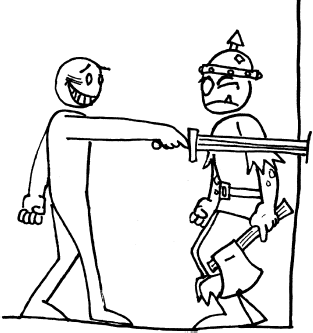
If you take any martial art, you quickly learn that moving is just as important as attacking. The goal in a real-life fight[121] is NOT to get hit. Why should video games be any different? Allow your player moves that give them options for retreating or avoiding damage, and also ones that can be combined with combat moves for quicker or more powerful attacks.
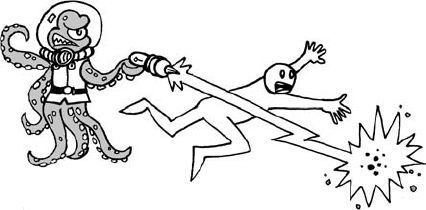
Dodges and rolls allow players to get the heck out of dodge and quickly move out of the way of attacks. They should be quick and easy to perform too: a button press and single control stick move. Mind your metrics. Make sure your dodge lets the player get completely clear of wide-range attacks and longer-reaching weapons like halberds and huge swords, or radius-based attacks like explosions and magic spells—otherwise you might be doing what they call in WOW "the graveyard hustle."
After the player does a dodge, there should be a beat to allow the player to get back on their feet. Not only does it give the player a chance to reorient themselves, but it keeps the player from using it as a movement exploit.
Allow players to use dodges and rolls to get past hazards. They add a nice moment of tension when dashing through a closing door or rolling under a swinging blade. But be careful. During a roll or dash, the camera has a tendency to collide with whatever the player is trying to avoid. I don't suggest having the camera to pass through the hazard (that looks sloppy) or have the camera dip down with the player (as that gets disorienting.) Consider the camera locking in place as the player dodges and then have it "catch up" with the player when they've cleared the obstacle.
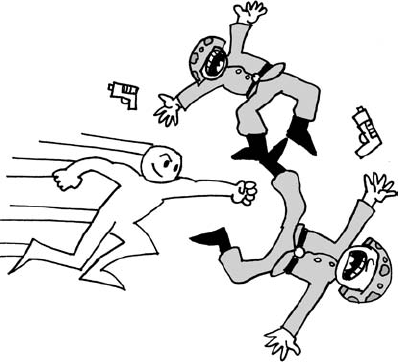
Dashes are forward moves that can be used for defense or attack. Like dodges, dashes should be very quick to perform. Many action games like Devil May Cry (Capcom, 2001) and Darksiders (THQ, 2009) have dash moves that can be upgraded with more powerful sword or punch moves. Even your basic dash move should do something besides move the player. You want a dash to feel quick and powerful. And fast. And dare I say, dashing?
The player should be able to use the dash to ram into enemies or smash breakable objects. Even though a dash targets one enemy, you can have the player's momentum continue to have him hit several enemies at once or create a "sonic boom" to send bad guys flying! Whee!
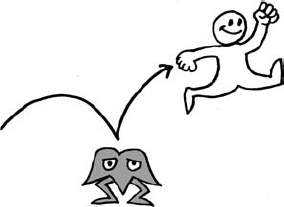
While generally used for traversal, jump moves can be combat moves too. Where would Mario be without his famous "butt bounce" attack? The collision zone should be like a good pair of pants; there should be plenty of room in the butt. Don't make these pixel-perfect attacks. After the attack hits, apply recoil bounce to move the player a short distance away so the player doesn't land on or next to the enemy and take damage. If the enemy hasn't been killed by the butt bounce, minimize risk to the player by putting the enemy in a stunned state.
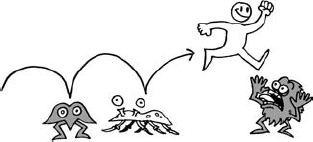
Many games allow the player to maneuver during this recoil bounce to let the player chain bounce attacks off of the heads of multiple enemies! Make sure you award an escalating bonus for each additional bad guy bounced. Make it a big moment for the player—they've just done something cool!
You don't have to be a short Italian plumber to do jump attacks. Weapon-wielding tough guys can do these moves too. Just make sure you follow these guidelines:
Make sure the player's maximum jump is taller than the tallest enemy you can jump attack. Otherwise you'll be colliding with the enemy's head or shoulders, which will look strange.
When the player lands, apply the same rules as an attack impact: stop the action for a beat by freezing the enemy or world's action, generate explosive effects, rumble the controller—anything to make the attack feel more powerful.
Even if the player misses, the strike could generate some radial effect; a stun or knock back for nearby enemies, for example.
Allow the player a quick recovery—they'll want to get back into action immediately.
Then again, you could give the player a delay as part of the risk/reward of perfoming the attack. For example, Mario firmly plants his butt into the ground after a butt bounce. If he misses an enemy, he's vulnerable for a beat to getting hurt by an enemy.
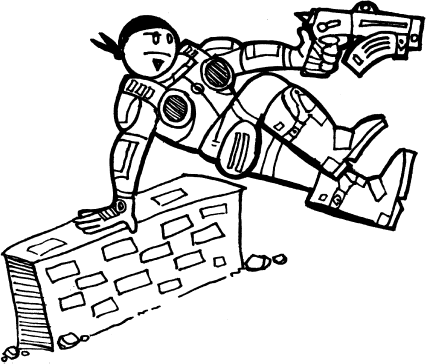
If jumping is a little too frivolous for your big bad space marine or soldier, you can have them vault over obstacles to add variety to battlefield movement. Vaulting works well with cover systems (see below) and ducking. Gears of War 2 (Microsoft Games Studio, 2008) provides players with a prompt to notify them when they can vault over a low wall.
That's how fast you have to respond to an attack, so you'd better make sure your block is quick to pull off! Blocks can be either general or positional.
General blocks are found in action games; a single button press to cross weapons, arms, or lift a shield to block an incoming attack. They're an all-purpose block for any situation and enemy. It doesn't matter if your shield is a one-handed buckler or Roman Scuta, the function is still the same: the player blocks an attack with the press of a button, holding it aside during the rest of combat.
Don't underestimate the use of sound effects in conjunction with a block. A nice loud CLANG! lets the player know they've successfully executed a block. Or have sparks or some other effect (as long as it's not blood) visually clue the player in. Some blocks displace the player back a little bit to make the player have to move back in to hold his ground. Giving a successful block a disadvantage is a bit douchy, but if you want to, then go ahead—it's your game.
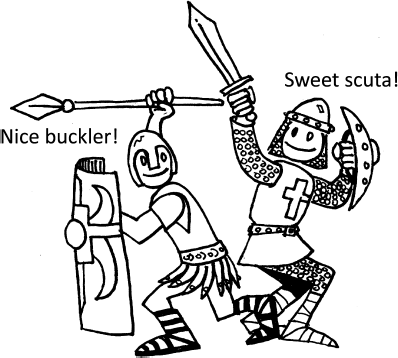
Positional blocks correlate to a particular elevation and require a stick move and/or button press to block at the appropriate height, whether it's a high or low. You find these blocks most often in fighting games. You'll have to decide whether a player can hold a block or not. Arm blocks are usually quick and drop down after a second or so. Other fighting and action games allow the player to hold the block indefinitely, or at least until an enemy does an attack that breaks the player's block or knocks them off their feet. Shield blocks can last longer, allowing the player to "hide" behind the shield for an extended period of time. Some designers don't like letting the player camp a block, but that can be circumnavigated with breakable shields or giving enemies knockback attacks. Oh, and don't forget to prevent your shield from sorting through the ground when the player crouches to block low attacks.
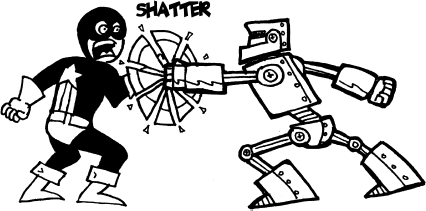
As a designer, you need to decide whether your shield is breakable or not. It will make a big difference to how the player uses it. In the first Maximo game, we had a breakable shield. The player was able to upgrade it to a stronger shield through the course of the game. However, as it was still a limited resource we found that players were reluctant to use it, preferring to jump and dodge out of the way of attacks instead. In the sequel, we wanted to promote shield usage, so we made it unbreakable. Players were much happier to block now that the worry of breakage was taken away. But shields aren't just for blocking anymore:
Combine with dash move to clear obstacles
Smash enemies at close range
Throw a shield as a short-range projectile
Use the shield as a sled down steep inclines
Place shield over head to protect from falling debris or lava
Use shield as a crowbar to move large objects
Keep shield on back to protect from back-stabbing enemies.
Heck, attach a shield to a chain like in Rygar, and it becomes a whole new weapon!
If a shield isn't enough protection, then armor will do the trick. There are several things to consider when giving the player armor. Encumbrance is one. The more armor the player wears, the slower (and noisier) the player becomes. You usually find encumbrance in RPGs, not often in action games. It's fine if you are trying to be "realistic" but if your game's emphasis is on action and combat, it may be better to not use it.
Perhaps your game makes a distinction between different parts of the body in combat? If so, you can use the "paper doll" approach to armor. The player has to armor his head, torso, arms, hands, legs and feet. This feels more realistic and gives your player more items to buy and collect. However, it does require an interface—usually quite large, as it has to show the entire body. Make sure it's easy for players to find, select and change their armor. And discard or sell unwanted armor as well.
Your hero has finally defeated the first boss and won his prize: a new suit of armor. But don't cop out and just give your player a +2 chainmail shirt. Whenever the player earns an armor upgrade, make it look dramatically different. For example, full plate looks substantially different (and cooler) than a leather jerkin. By visually improving the player's armor, the player can tell their "rank" at a glance.
Give it a unique name too, like the "Holy Armor of Protection" or "Dragon Scale Armor." This will make the player feel like they've won something important and worth having.
But armor is not just for protection. Isaac's spacesuit in Dead Space has a health meter right down the spine. Players can check their status at a glance without the need for a HUD.

Ghosts 'N Goblins also shows health status but in reverse: as the armor pops off, the player gets closer to death. This is a good trick for enemies too, as it lets the player know how many hits are left to defeating a foe.
Armor upgrades are a great way to give a player a new ability. Can't move that heavy block? This hydraulically powered armor can help you move it. It doesn't even have to be a "suit of armor." Mario's Tanooki[122] suit not only added protection, but let him fly, grow, and turn into an invincible statue.
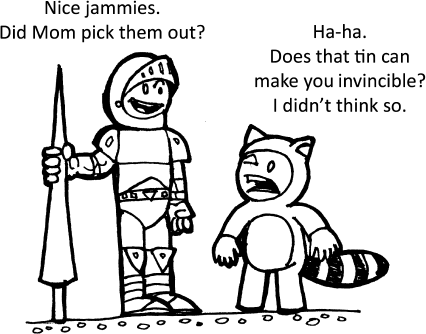
What's great about armor is it's an easy way for the player to customize their character without changing the base model. World of Warcraft does it right. You can find, buy and even make custom gear—and when another player sees your pimp helmet, they're gonna want one too. It's a great way to motivate players to spend more time in your game. It doesn't have to be armor; it can be hats, unique weapons or mounts. The more customization you allow the player, the better.
Ooooh! Guns, guns, guns!
Clarence Boddiker (RoboCop)
Shooting is simple. Aim the gun, pull the trigger. Right? But let's look at some of the most popular multiplayer shooters and see how wide they vary from each other:
Quake has maps that promote linear action and predictable looping movement patterns. Weapon and armor pickups can change the dynamics of the action in a heartbeat.
Halo is played more like a sport, with game-like modes of play. The rhythm of the action is slower than many shooters, partially due to the player's regenerating health, promotes "attack then retreat" strategies. Vehicles play a big part of the gameplay as well.
Call of Duty: Modern Warfare has a multiplayer mode that concentrates on short-range combat with intense action. Players can concentrate on upgrading their weapons and characters like in an RPG.
Team Fortress 2 resembles an RPG but the players assume widely varying skill-based roles. The game modes promote teamwork over single player actions.
Left4Dead is also all about teamwork; in fact, you can't win without it. While most multiplayer shooters match opponents one-to-one, Left4Dead pits a handful of players against an endless horde of zombies. Game modes resemble stories more than in other shooters.

Even in games where shooting isn't the main focus of play, ranged combat can immediately change the dynamic of the game. This is why I recommend that if a game isn't a shooter then guns should be saved until later in the game. Let the player get used to their moves and attacks without a gun first. When you feel like they've learned all they can, then go ahead and arm them.
Creative Director Hardy LeBel, who has designed many successful shooters like Halo: Combat Evolved and SOCOM 3, says that ranged combat is about building a distinctive rhythm. There are several factors that influence that rhythm such as targeting methods, reload times, weapon fire rate, weapon accuracy, rate of fire and lethality, the availability of ammunition, the availability of area-of-effect weapons like grenades, player health mechanics, and so on. Even level design, AI behavior and mechanics all contribute to that rhythm. Whew! That's a lot to digest at once, so let's start with the three As: action, aiming and ammo.
Action is the loading, firing and unloading of a gun. Here are some questions you need to ask about a weapon's action:
Does the player need to reload with a button press or does it occur automatically? You can create some great risk/reward gameplay around reloading a gun, as the player is vulnerable during loading (such as in Gears of War, where a properly executed manual reload is faster, but a botched one is even slower and leaves the player defenseless for longer).
Is there a limit to the ammo? Does the player even need to reload the gun at all?
What is the gun's rate of fire? A faster firing gun is going to use ammo quicker than a single shot weapon. Can the weapon be fired one shot at a time or in bursts?
Does the firing bloom obscure the player's view?
Can a shot take out more than one target at a time?
Aiming is how the player sights a target. Aiming is a huge issue in games. It can make or break a shooter. Early shooters relied on the player's reflexes and skill in positioning the cursor over the target and pulling the trigger at the right time. Until Halo: Combat Evolved (Microsoft, 2001), most successful first-person shooters were played on PCs—partially because of the ease of aiming with a mouse. To help players manage the tricky task of aiming with the Xbox's analog sticks, the game used aim assist.
No matter what type of aiming method you use (aim assist, auto-aim, free aiming, and so on), you need to design and implement targeting mechanics for the tastes of your target audience.
How does the player aim? Is there a scope? How much of the player's view does the scope obstruct?
How does depth of field affect aiming? An effective visual trick is to have far-away objects that are blurry suddenly become clear when viewed through a long-range sight.
Is aiming manual? Does the gun have drift? Can the player steady their shot? From how far away can a player make a shot?
Is aiming automatic? Is there a quick-fire mode? Is there an auto-aiming/lock on system?
When you fire the gun, does it kick, throwing off the player's aim? Does it rise like a Thompson submachine gun?
Are there systems to improve the player's aiming such as laser pointers, bullet time or heat-seeking ammo?
Can the player move while aiming? Are there limitations to where the player can aim, like diagonally or overhead?
Does the scope detect other ways of seeing the target such as IR, motion detection or heartbeat? Can the gun be modified in any way to become silenced or have additional add-on weapons like grenade launchers or bayonets?
Can the player use shooting for puzzle solving, or trick shooting? Shoot targets? Shoot locks off of doors? Shoot the gun out of the hands of enemies? Ricochet a bullet into an enemy?
Can the player disable the targeting mechanism or replace it with another style?
The targeting reticule and/or the iron sights on your weapons should be one of the most sophisticated feedback mechanisms in your game. They will likely need to communicate aim, bullet spread, recoil, jamming, overheat, ammo, successful hits vs near misses, friend or foe, and the list goes on and on. And it will need to accomplish that while remaining useful and unobtrusive to the player. A great deal of time and writing could be dedicated to designing the targeting reticules for shooting, but suffice it to say this very important thing applies:
Taking some time to deconstruct the mechanics and behaviors of the best-in-breed games will add immeasurably to your own gameplay.
Ammo is what the player shoots. Ammo raises it own questions:
Where and how is ammo carried? Is there a limit to the amount of ammo carried by a player? Do you need the right ammo for the right gun?
Does ammo have any special effects like incendiary, poisonous, heat-seeking, or armor-piercing properties?
What happens when a shot misses a target? Does it impact against something in the environment? Does it affect that item? Break glass? Chip plaster? Ricochet off of metal?
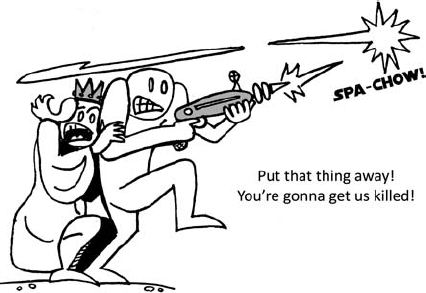
Here are a few more tricks to make your gunplay more effective:
Accentuate the excitement and danger of a gunfight with sound: weapon firing, bullet impacts, enemy gunfire, whizzing bullets, and so on.
Play the SFX of the gunshot and bullet impact at full volume regardless of the target's distance to the player. This will let them know whether they scored a successful shot. Don't forget to let the player hear the voiceover of the character, too.
Don't forget the weapon visual effects. Muzzle flash, spent shells kicking out and smoke from the barrel all make the experience more realistic.
In general, players like gunfights at shorter ranges, as they are more exciting.
Regardless of how graphic your weapon hits are, show some sort of impact effect when a bullet hits its target—from sparks to explosions to spraying gore.
Needless to say, level design IS game design when it comes to building the rhythm of ranged combat. If you design spaces that are long, open corridors and you have a high lethality combat model, players will play cautiously. If you have lots of cover and break line-of-sight frequently PLUS you have a regenerating health model, then gunfights will feel like swirling dogfights as players engage and disengage to heal.
Mr. LeBel leaves us with this important thought: "in general, players expect ranged combat to feel powerful and satisfying. It's an easy mistake to try and make ranged weapons weak to help offset the perception of too much power in the hands of the player; fight that impulse and try to remember to be "generous" to the player, and they will thank you for it."
When designing guns, even if you are creating made-up weapons, it's helpful to start with their real-life counterparts; after all, weapons are built for particular roles that can directly apply to their use in your game. But that will only get you halfway there. You should consider thinking about them in terms of effectiveness:
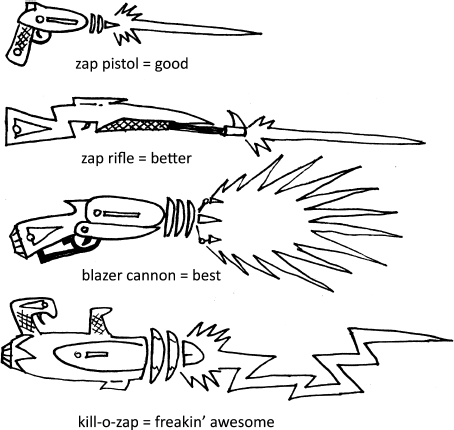
But balancing weapons can be tricky, especially if basing them on real-world equivalents. There are gun-nut players that have their own opinions about which gun is better and how they should perform. You could go crazy trying to please everyone, so base your weapons on what fits the needs of your game first. Here are some guidelines to get you started:
Pistols fire in a straight line (unless you are that guy from Wanted), which will dictate where you can shoot and who you can shoot. One enemy at a time unless your ammo pierces several enemies at once! That's going to keep the pace of shooting slow. Pistols usually require frequent reloading too, as their magazines carry from 6 to 15 rounds.
Rifles, especially sniper rifles, mean the player has to aim and shoot. You usually can't fire from the hip with a rifle. That means the player is going to be vulnerable and usually looking down a scope, which means tunnel blindness. Sounds like a good opportunity for an enemy to sneak up... Many rifles carry large quantities of ammo: some have drum magazines that hold up to 100 rounds.
Shotguns and flamethrowers fire in a cone, rather than a straight line. The cone is a shorter range than a pistol or rifle but can hit several targets at once. Both weapons do high damage to targets when hit at close range. Shotguns carry less ammo than guns or rifles, and flamethrowers go through propellant at a fast rate. A flamethrower's blast can be maintained for an extended time and does residual damage to an enemy.
Automatic weapons allow you to fire quickly, but accuracy goes out the window. This high rate of fire also uses up ammo fast, regardless of larger magazine sizes. Designing your machine gun to have a little kick, drift or spray will not only make it feel real, but push the player to master using the weapon accurately. Are your automatic weapons one handed or two? Can the player use two at the same time? This will determine what other actions the player can do while shooting.
Heavy weapons pack a big punch, but usually take a while to warm up or cool down. The Heavy's minigun in Team Fortress 2 takes a few beats to start spinning, but the player has a way to keep the gun spinning even when they aren't shooting with it. The disadvantage is enemies hear you coming a mile away... Grenade launchers are also harder to aim, but do big damage. The Call of Duty games change the targeting on their grenade launcher to make it feel different and less accurate. The result is a very different "shooting" experience than a pistol or rifle. Magazine sizes vary from a dozen grenades to hundreds of rounds for fast-shooting miniguns.
No matter what the weapon, think about the range, speed and strength of the weapon. You can use an attack matrix like the one below to track these values and compare and contrast your weapons for maximum variety.
Weapon | Range | ||
|---|---|---|---|
Short | Medium | Long | |
Dual pistols | Strong | Weak | N/A |
Assault rifle | Strong but slow | Very strong | Weak |
Shotgun | Very strong | N/A | N/A |
Sniper rifle | N/A | Medium | Very strong |
Notice how there is very little overlap in weapon attributes, and any overlap that does exist has a disadvantage like shooting/reloading speed. Keeping the weapons distinct will help in making the game feel well rounded.
Ranged combat weapons aren't always guns. Fantasy games, for example, have a wide variety of projectiles from arrows to magic missiles to cones of cold. Regardless of the genre, as long as you design your ranged combat with the guidelines set down for guns: range, damage and the three As, you should be fine.
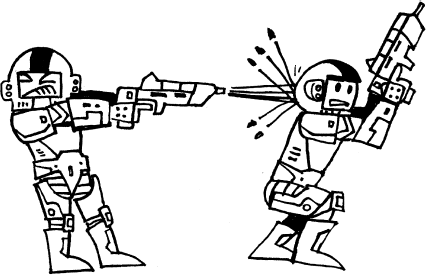
One last question to ask is in a multiplayer game, should you allow friendly fire or not? It totally depends on the gameplay mode. It seems much more logical to have friendly fire in a player vs player mode than in a cooperative mode. Whatever your choice, allow the player to turn it on or off.
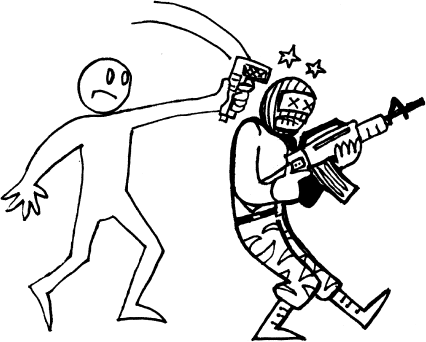
Oh no. You've just run out of bullets. Now what?
Players feel incredibly powerless when they're playing a shooter and have nothing to shoot with! So give your player a melee weapon that is always available. It can be a knife, fists or even a pistol whip or clubbing attack with a rifle butt. Giving the player this option to bash the baddie allows things to feel fair and realistic. The Gears of War games don't mess around in this department: they give you a chainsaw mounted onto your gun!
They say you can never have enough guns, but you don't want your player to be carrying around a golf bag full of firearms. Many games limit weapons to a main gun and a side arm. But if you do that, you'll need to be able to switch between them quickly; preferably with a single button press.
Call of Duty: Modern Warfare 2 allows you to draw your side arm faster than you can raise your rifle; helpful for those situations requiring a quick shot.
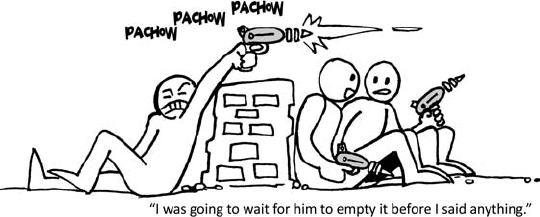
Gears of War and Uncharted use a cover system. This not only allows the player a way to take cover against surface or barricade to avoid being shot, but to also fire "blindly" or in a limited manner at the enemy. The player is often penalized for avoiding risk by not being able to aim while under cover. Cover systems usually require a button press or command by the player to place them in and out of this mode. Be careful that your cover system doesn't become too "sticky", otherwise the player may be going into cover when they don't want to.
There are many, many ways to shoot at things in video games: from a plane, from a train, out of a box, at a fox—you name it! Here are the main elements of a shooting gallery screen:
Turret showing weapon and player
Shootable object containing reward or powerup
Ground-based target
Visual element that indicates why the player can't shoot "past the screen"
Aerial target (note the clear indication to the player that it has been hit)
Smaller aerial target (generally worth more points)
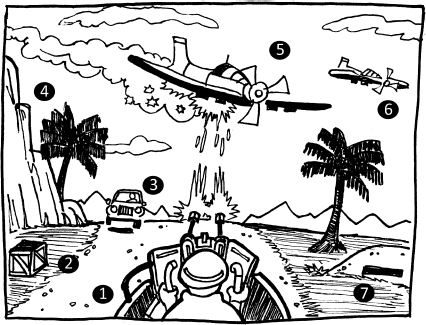
Mounted ranged combat is a shooting gallery style gameplay where the players defend against waves of incoming enemies. Players will tend to fire constantly if the weapon has unlimited ammo, or in short bursts if it doesn't. You can also get the player to fire in bursts if the weapon needs a cool-down time. To help the player aim, add tracer bullets. Not only does it look cool, but it will help players get "leads" on fast moving enemies or ones with erratic movement patterns. Let the player know the range of the weapon. If the player can't reach a target, then create a good visual justification as to why there are areas of the screen the player can't hit.
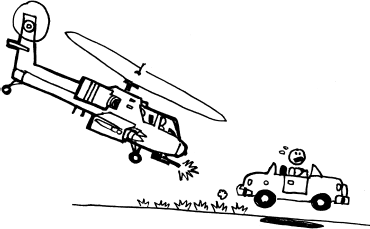
As both the target and the weapon move during aerial combat and vehicular combat, give the player opportunities to line the target up in their sights. If the player has a chance to see the target coming, line up the target and fire at the target they will feel in control. If too many targets whip by the player without giving him a chance to react, the player will resort to firing blindly which will make the experience seem mindless and frustrating. Adjust the speed of the targets or the craft either naturally or artificially to give the player ample shooting opportunities.
Rail shooter gameplay happens when player movement control is taken out of the equation. Games like House of the Dead: Overkill (Sega, 2009) and Star Fox (Nintendo, 1993) are rail shooters. You can also find rail shooter sequences in titles like Red Faction Guerrilla, Uncharted 2 and Wet.
A unique advantage of rail shooters is that the game developer has complete control over the game camera and the sequence of events. This allows the developer to create scares they know the player will experience, furious shooting sequences and dramatic scripted events.
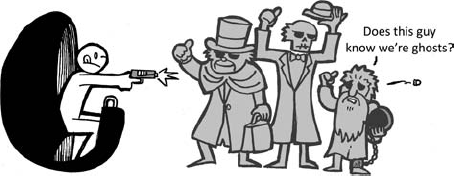
In fact, some rail shooters bear more resemblance to a theme park dark ride like Disneyland's Haunted Mansion[123] than a video game. In fact, interactive dark rides have started to appear in theme parks around the world[124], completing the circle of inspiration from dark ride to video game to dark ride.
You don't really need a gun or melee weapon to defeat enemies. There are so many ways; one hardly knows what to choose! The more variety you introduce into your combat, the more fun the player will have:
Grenades. When throwing grenades, allow the player to predict the arc. Gears of War and Uncharted both have "throw path" targeting aids to assist the player. Don't neglect the effects when those suckers blow. Kick up dust, debris and blow props sky high to really sell the explosion.
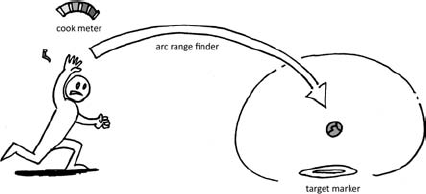
Throwing a grenade should always carry the risk/reward of having it accidently go off if held for too long, or even bounce back at the player. Soldiers "cook" their grenades by holding on to them after pulling the pin to make sure it goes off where it lands. Call of Duty: Modern Warfare not only uses a HUD element to warn players of an incoming grenade, but allows players to pick it up and throw it back! Remember that grenades can also be shot from rifles and launchers for greater accuracy and range.
Since many players duck back under cover after throwing a grenade, make sure you provide enough sound, visual and controller rumble cues to inform the player when a grenade detonates, even if they aren't looking at where it landed. If a player gets too close to an exploding grenade, don't hesitate to blow them up as well.
Sometimes you just need to blow up everything. It doesn't matter if you are calling in carpet bombing or a magical meteor storm; smart bombs are great one-shot solutions to keep the baddies off your back, if only for a few seconds. Show the player the controls for a smart bomb so they don't confuse it with a regular attack. When activated, smart bombs should destroy everything on screen save the player. If there are destructible items, they should blow up too.

You have a few options to how the player can activate a smart bomb, depending on how much tension you want to create. In Defender, the smart bomb is immediate while in R-Type, the player has to charge up the smart bomb before firing it. Let them know what they are working toward so they can make an accurate decision as to when to use it. Be careful that you don't let it charge up too fast or be used too frequently, otherwise all the bad guys in your carefully designed combat encounters will be wiped out in the blink of an eye!
Wherever there are explosions, there is fire. Sometimes there's fire even without the explosions—things just need to be burned. Fire creates great-looking visuals and lingering damage to enemies and environments. But fire takes no sides: players should get hurt by fire if they stray into it. The fire should eventually burn out so the player doesn't paint themselves into a napalm-colored corner.
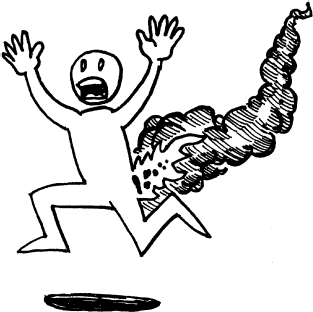
Fire also means flamethrowers. The closer you are to your enemy, the more damage a flamethrower should do. Flamethrowers are the weapon of choice for players who don't like to aim. Allow them to "fire and forget" or "hose down" enemies with flame.
Don't forget to use fire-based weapons as a gameplay mechanic too. Flaming swords and other weapons don't just do extra damage to ice-themed enemies, they can ignite braziers, detonate explosives, burn through rope, illuminate dark areas, cauterize wounds; the gameplay possibilities are vast.
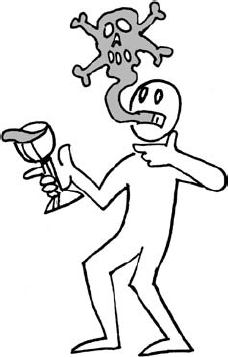
Another lingering indirect attack is poison. Make sure you have an associated visual for poisoned items. A green gassy effect, a dripping blade, a hovering "death's head" effect are all traditional video game indicators of poison. Players should be able to tell when they are wielding a poisoned item or have poisoned an enemy—make the visual unique and distinct. As a poisoned character loses health, make sure each increment that the poison takes has a clear sound effect and visual effect associated with it. You are creating a timer in which the focus of the player will shift from regular gameplay to "find and administer the antidote." If the antidote is an inventory based item, don't make it too hard for the player to retrieve it. Even if poison is uncommon, make the antidote more common. There is no worse feeling in a video game than making the player feel like death is inevitable. Always give them a fighting chance.
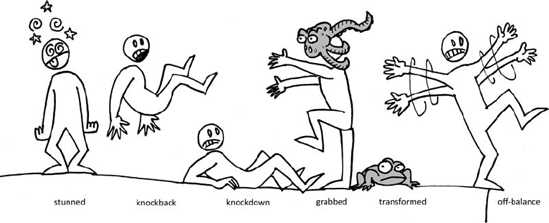
Another horrible feeling for players is to take control away from them. While stunning, knockback, transformation, loss of balance and sliding are worthwhile tools to use in lieu of taking damage, they should be used judiciously by the designer.
Stun. When hit by a stun, the player loses all control of the character for a short period of time, usually leaving the player in danger of being hit by an enemy attack or finishing move. Stuns are usually accompanied by visual (like cartoony stars or "tweeting birds") and sound effects.
Knockback. The player is knocked back through the air a short distance then falls to the ground. A knockback (or KB) can be lethal if a player is on a platform or next to a ledge. Be careful not to put the player into a situation where they can be "double bolted[125]" by KBs.
Knockdown. The player is knocked to the ground, which requires a second or two to get back up. While on the ground, the player is vulnerable to additional attacks. In some games, getting back up is automatic, in others it requires button mashing, stick waggling or a QTE.
Latching on. An enemy grabs or latches on to the player, pinning their arms and restricting their movement. Enemies can cause damage for every second they are latched on. Enemies can be shaken off by waggling the controls, or performing jump or spin moves.
Transformation. The player has been hit by a magic spell that transforms the character into some other form. In Ghosts 'N Goblins, Arthur turned into a frog. In Maximo, the hero could be transformed into a zombie, an old man and a baby. In all cases, the player's move set becomes limited; they cannot attack or jump and in some cases, lose almost all control. During a transformation, game controls can be reversed to sow player confusion (for example, push controls left and the player moves right). I recommend ending the transformation quickly. Reserve for special occasions as the player will tire of it if used too often.
Loss of balance. This animation is used as a teeter move. The player briefly loses complete control as the character reacts to losing their balance. This works well as an indicator rather than a disabling move.
Sliding/skidding. After a run, dash or jump move, the character slides to regain their balance. While this adds quite a bit of personality to the character, it can be annoying especially when it happens several times in a row as the player struggles to bring the player to a stop. Like a KB, a skid can slide a character right off the edge of a narrow platform.
Don't let enemies have all of the fun! Design enemy-disabling attacks to give your players the advantage in combat. Use caution when creating attacks with these types of results. Consider what it is adding to the gameplay. Ask yourself this very important thing:
In order for all this combat to mean anything, the player has to have something to lose. That means health and lives.
To calculate the player's starting health, I suggest calculating in terms of the maximum damage the player can take. For example, at the beginning of the game, your hero can take 20 hits from enemies before losing a life and without replenishing health. Next determine how much damage an average enemy's attack does. In this example, a normal hit will cause 10 hit points of damage. That means the player's starting health should be 10 × 20 hit points = 200 health.
There are many ways losing that health can be represented to the player. Numbers are simple and transparent but boring. They stand out against cluttered HUDs like those found in MMOs and RPGs. Just keep the font legible.
A health bar doesn't take much space running along the top or side of the screen. They can be framed with themed artwork to make them look more interesting and part of the HUD. However, it can be difficult to tell when small amounts of damage have been taken. A health bar can be segmented for readability.
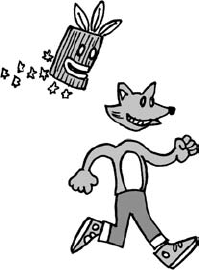
If you are feeling artistic, icons can represent the player's health with simple visuals: human outlines that go from green to red (WWE Smackdown), crystal globes of blood (Diablo) or hearts (Legend of Zelda).
Some platform games use a companion character as the player's health meter. For example, Crash Bandicoot is followed by a tiki head that loses feathers with each hit the player takes. The problem with this system is that it cannot support a large amount of health.
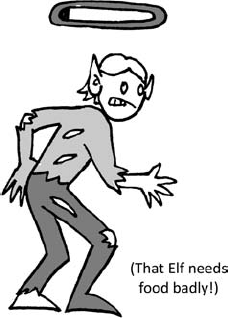
Things are more direct with character-based health systems. Ghosts 'N Goblins represents health with armor that pops off the player. Dead Space and Ghostbusters have status meters as part of the character's armor or equipment. The characters of Resident Evil clutch their midsections and limp when they've taken damage. Many car combat and driving games show visible damage to the vehicle. You know your car is close to death in Grand Theft Auto when you are dragging a bumper and your engine is smoking! Whatever method you use, you need to have some sort of feedback: the player can't always keep their eye on the health bar, so these character-based feedback mechanisms make it possible for the player to gauge how close to death or restart they are. They can then adjust their strategy (retreat, heal themselves, etc.) based on this knowledge. Just make sure these systems don't interfere with the player's movement or attacks.
Many modern games have moved towards a HUD-less health system. As the player takes damage, the screen becomes splattered with blood which gets thicker as more damage is taken. More dramatic effects, like turning the whole screen blood red, monochromatic or blurry, can be used too. Sound and music can drop off and be replaced by heavy breathing and a heartbeat. In Batman: Arkham Asylum, whenever the player is hit by a taser attack, the screen's video "short circuits."
Other systems that defy classification have shown up over the years. In Sonic the Hedgehog, as long as the player holds one collectable ring, they cannot be killed. Or at the other end of the scale, Bushido Blade 2 featured so many one-hit kill attacks that the health bar was completely dropped.
Players can regain health with the aid of power-ups, increases in level or experience and even time. Halo: Combat Evolved pioneered the concept of regenerating health in first person shooters. As long as the player wasn't taking damage, the health meter would refill at a slow but steady rate. The Ratchet and Clank games ditched health altogether as the developer wanted the player to reach the end of the game, not constantly see a game over screen.
Whatever method of displaying health is used, the player should clearly know when they are getting hurt and losing health. Don't skimp on the dramatic animations and particle effects. Both a hit sound effect and a vocal reaction ("ow!", "oomph!", and so on) should play. Health should deplete in a very obvious manner, because with every hit the player is closer to losing their life.
Let's face it, lives and the game over screen are an outmoded concept.
When video games first arrived, their goal was to suck quarters as fast as possible out of the player's pocket. The best way to achieve that was to make the player want to keep playing despite being killed as often as possible. Additonal lives became a good short-term goal for the player to keep in the game. When game characters became little people in lieu of blips and spaceships, the concept of dying came with them. (After all a spaceship doesn't die, does it?) The emotional impact of the finality of dying (Unless ... Quick! Get that next quarter into the slot!) was too good to pass up.
When games moved to home systems, lives followed—but the players had paid for their game and there were no more quarters to gain. So why kill the player? Why not let them finish the game they've paid for?
Another problem with killing off a player often is that it discourages the player from continuing the game fairly. For example, players of Doom (id,1993) found that it was easier to restart the game from a saved file than it was from an in-game checkpoint. By using this exploit, the player ceased to worry about death and never even saw the game over screen.
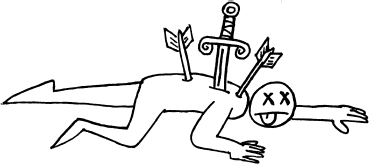
Many developers have caught on to this and abandoned the concept of player lives. Instead of killing the player and ending the game, players are reset to checkpoints within the level, where they can keep trying over and over until they succeed. In Prince of Persia: the Sands of Time, the player can "rewind time" to a point where the player is safe. This type of mechanic has to be carefully implemented though: it is possible for a player to get into a situation where they can't rewind far enough to avoid death and would die all over again. A narrator tells the player "that's not how the story happened" before the character restarts from a checkpoint. In Batman: Arkham Asylum, the player is given a chance to save the caped crusader from a fall to death by pressing a QTE button. If successful, Batman climbs back up to safety.
However, some genres like action and survival horror still utilize lives and game over screens. If you have to kill your player, remember the following:
Let the player know that they have lives and that they will be lost. Players become protective of their character and will fear for their safety.
Display lives clearly in the HUD. Make it clear when the player is losing a life.
Allow the player plenty of opportunities to regain lives. They can happen during level ups, be power-ups, or rewards for collecting objects.
When killing a player character, do it quickly. Don't create a long, drawn out death animation that the player has to watch over and over again when things get hard in the game.
The same goes for game over screens. Don't make the player sit through long death sequence cutscenes. Make the path to restarting gameplay after death as quick as possible.
When killing a player, make it as violent as your rating allows. Let the player really feel some pain when it happens. Empathy toward the game character will motivate the player towards self-preservation.
If the player earns something during one life, don't double punish them by taking it away from them when they lose that life.
If killing the player during a boss round, don't make the player have to play the whole sequence all over again. Why not let them continue on with the fight as if nothing ever happened, or only punish them with a little bit of boss health regained?
That said, the threat of death is a great motivator for the player to do better and learn that skill or control. Just use this power judiciously, okay? I trust you.
If using alternate death systems, like the player dies if their NPC partner dies, make it clear that (a) the player needs to protect the partner character with their lives and (b) they will die if they don't.
Think very carefully about using lives in your game. If you don't think killing the player will make the game experience better or more exciting, or think it will actually be more frustrating, then don't do it. Because this very important thing applies:
Never give the player a good reason to stop. Once you've lost them, you may never get them back. Instead of a game over screen, why not create a "keep going" screen? When the player dies or leave the game, show them a preview of the next level, the next story point or the next treasure item, weapon or powerup? Give the player a sneak peek to get them so excited that they won't want to stop playing!
Now stick close, we're moving into dangerous territory in the next level: one populated by hordes of enemies!
Level 10's Universal Truths and Clever Ideas:
Be mindful of ESRB guidelines when creating violent gameplay.
Violence is all about context: a violent act is going to feel more violent if it is the player who does it.
Give your character a signature attack or weapon.
Create an attack matrix to track your combat moves and reactions.
People want to play games that make them look cool.
Use a lock-on system to enable the player during combat.
Close battles are more exciting.
Use QTEs to heighten combat drama but don't overdo them as they get old.
Fighting enemies is supposed to be fun.
Be aware of the three As when designing projectile combat.
Use attacks to hamper and incapacitate the player rather than kill.
Make it clear to the player that they have taken damage.
Always strive to enable the player even when disabling them.
Keep the player playing.
[117] The fact that a developer called "id" created the FPS, a genre that directly adheres to Freud's pleasure principle, is almost too delicious to ignore.
[118] EA's marketing team tried to cancel their best selling game, The Sims, during its entire development; they thought no one would buy it!
[119] http://www.esrb.org/ratings/ratings_guide.jsp
[120] The Mark of Kri (SCEA, 2002) had an innovative lock-on system that had the player use the DualShock controller's analog stick to do a "radar style" sweep to target a sequence of enemies that could be programmed by the player. The technique was patented by the game creators.
[121] Not that I'm advocating fighting in the real world: remember, the first rule of fight club is ... oops, I've already said too much.
[122] Tanuki are Japanese raccoon dogs. Mario wears Tanuki footie pajamas with raccoon ears. It's adorable. Really.
[123] This reminds me of the time Disneyland's Haunted Mansion literally became a shooter. In the summer of 1974, a Disneyland guest wielding a .22 pistol took a shot at one of the duelist ghosts in the Ballroom scene. The bullet made a hole in the giant pane of glass used to create the scene's pepper ghost illusion. The management was frantic. It had taken a helicopter to originally install the giant sheet of glass and they'd have to rip the ceiling off the ride in order to replace it. However, a clever imagineer took one look at the spider-web cracks in the glass and slapped a rubber spider over the bullet hole. Voilá, problem solved! The spider is there to this day.
[124] On your next vacation, why not travel the world playing interactive dark rides? Buzz Lightyear's Space Ranger Spin (Walt Disney World, Florida), Men In Black: Alien Attack (Universal Studios Florida), Laser Raiders (Legoland Windsor, UK), Challenge of Tutankhamen (Six Flags, Belgium), Labyrinth of the Minotaur (Terra Mitica Theme Park, Spain) and Toy Story Midway Mania (Disney's California Adventure); all dark ride rail shooters.
[125] The term "double bolting" comes from the Ratchet and Clank games when a player is hit by an enemy and loses bolts, the game's unit of currency. The bolts disappear if not collected after a period of time. However, there are some situations where the player is knocked by an enemy into another hazard or enemy which causes more bolts to fly out of the player. The player is stunned by the attack and cannot regain control fast enough to collect any of the first bolts before they disappear, let alone the ones that were just knocked out of them. Thus they lose double the bolts from the initial attack.
